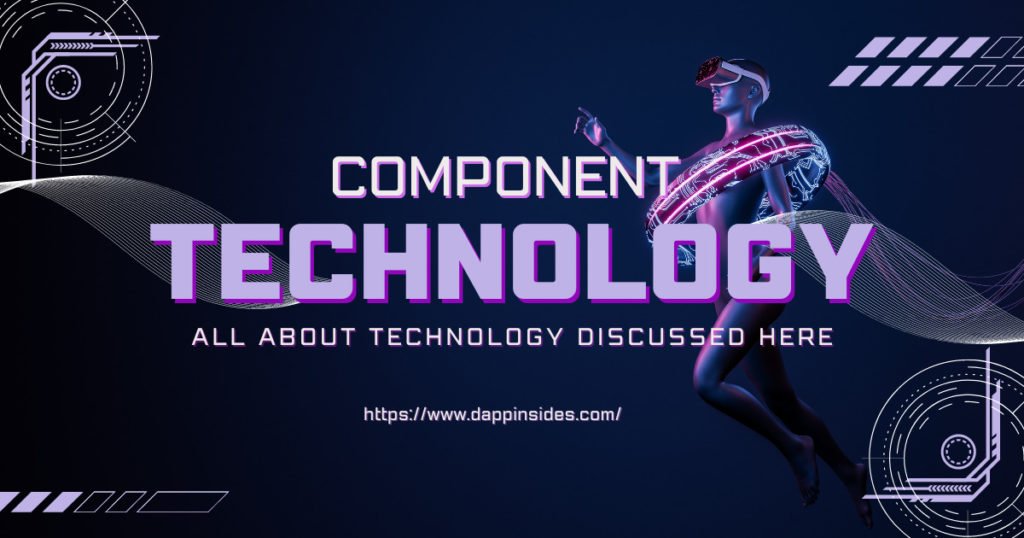Blogging Knowledge
Component technologies: Advantages of Component Technologies

Component technologies are like using building blocks to create complex things in technology. Imagine having different LEGO pieces that you can easily put together to make something cool. In the same way, with component technology, we use pre-made parts to build software and gadgets. It helps save time and makes it easier for different people to work together on big projects. This way, we can create new things faster and make technology that fits our needs. So, component technology is all about making technology simpler and more creative! Read More…
What are Components?
Components are like small, ready-to-use parts that do specific jobs. They’re like puzzle pieces that you can easily fit together to create something bigger. In technology, components are like building blocks for making things like software or gadgets. Each component has its own job, and when you put them together, they work as a team to make something work. It’s a bit like how different components come together to make a delicious recipe – components are the components that make technology work!

Component technologies are like using building blocks to create complex things in technology. Imagine having different LEGO pieces that you can easily put together to make something cool
What are the Different Types of Components of Technologies?
- Hardware Components: These are the physical parts of devices like computers and phones. They include things you can touch, like the screen, keyboard, and chips inside.
- Software Components: These are the instructions that tell devices what to do. It’s like the apps and programs that run on your devices and make them work.
- Input Components: These are ways to give commands to technology. For example, a keyboard, mouse, or touch screen lets you tell your computer what you want it to do.
- Output Components: These show you the results of what technology is doing. Like the screen displaying a picture, or speakers playing music.
- Processing Components: These are like the brains of technology. They take the instructions from software and use the hardware to do the actual work.
- Storage Components: These keep your data safe. Think of them like digital closets where you store files, pictures, and everything else.
- Networking Components: These help devices talk to each other. Just like how people use phones to call each other, devices use networking to communicate.
- Power Components: These provide energy to make technology run. It’s like the battery in your phone or the plug that connects to an outlet.
All these components work together to make our gadgets and technology do all the amazing things they can do!
Advantages of Component Technologies
Component technologies offer several advantages that contribute to more efficient and flexible development in the technology field. Here are some key benefits:
- Reusability: Components are like building blocks that can be used and reused across different projects. This saves time and effort, as developers don’t need to create everything from scratch each time.
- Modularity: Each component serves a specific function and can be developed independently. This portable makes it easier to manage, update, and replace individual components without affecting the entire system.
- Faster Development: By using pre-built components, developers can focus on assembling them rather than writing code or designing functionalities from the ground up. This accelerates the development process.
- Collaboration: Developers can work on different components simultaneously, fostering combination and parallel development. This collaborative approach speeds up project completion.
- Customization: Components can be combined in various ways to create customized solutions. It’s like mixing and matching LEGO bricks to build different structures. This flexibility caters to specific requirements.
- Quality and Consistency: Components that are tested and proven can enhance the overall quality of the final product. Consistency in using established components helps avoid errors and bugs.
- Maintenance and Updates: Since each component is separate, updates or fixes can be applied to specific parts without affecting the whole system. This simplifies maintenance and reduces downtime.
- Cost Efficiency: Reusing components reduces development time, which in turn lowers costs associated with creating software or technology solutions.
- Interoperability: Components can be designed to work well with each other, promoting interoperability between different systems and technologies.
- Scalability: As projects grow, components can be added or expanded upon, enabling scalability without having to overhaul the entire system.
Overall, component technologies provide a systematic way of creating technology solutions by breaking them down into reasonable parts. This approach optimizes development, enhances collaboration, and empowers developers to create more robust and innovative products efficiently.

Conclusion of Component technologies
In the world of technology, component technologies emerge as the solution to building smarter, faster, and more flexible systems. By using these digital building blocks, developers can create intricate solutions with less effort. The reusability of components means we don’t have to start from scratch every time. This approach fosters teamwork, speeds up development, and ensures that technology keeps evolving. As we bid farewell, we’re reminded that component technologies make our digital world more efficient, collective, and exciting than ever before.
FAQs About Component technologies
Q: What are component technologies?
A: Component technology is an approach in which technology systems are built by using small, specialized parts called components. These components can be easily combined to create larger and more complex systems, making development more efficient and flexible.
Q: Why is component technologies important?
A: Component technology simplifies development by allowing developers to reuse existing components, saving time and effort. It also promotes collaboration, as different developers can work on separate components together , speeding up the overall process.
Q: What are the benefits of using component technologies?
A: Using component technology offers advantages like reusability, faster development, customization, easier maintenance, and scalability. It encourages innovation, reduces errors, and enhances the quality of technology solutions.
Q: How do components work together in technologies?
A: Components are like puzzle pieces that fit together to create a bigger picture. They each have specific functions, and when combined, they create a complete and functional technology system.
Blogging Knowledge
Understanding TER Reviews: A Comprehensive Guide

Introduction:
TER Reviews, or The Erotic Review, is a platform where users can find and share information about adult entertainment services. It’s essential to understand how to navigate and use TER reviews effectively. In this comprehensive guide, we’ll break down what TER reviews are, how to interpret them, and how to make informed decisions using this platform.
1. What is TER?
TER, short for The Erotic Review, is an online platform that serves as a hub for individuals seeking adult entertainment services. It offers a space where users can share their experiences and insights about escorts, masseuses, and other adult service providers.
2. Navigating TER Reviews:
- Registration and Access:
- To access TER reviews, users need to register for an account. It’s essential to follow their registration process and guidelines.
- Search Functionality:
- TER allows users to search for providers based on location, services offered, rates, and other criteria. Users can filter results to find providers that match their preferences.
- Review Ratings:
- Reviews on TER typically include ratings for various aspects such as appearance, performance, and attitude. Understanding these ratings helps in assessing the quality of a service provider.
3. Interpreting TER Reviews:
- Reading Reviews:
- Reviews often include detailed accounts of the user’s experience with a particular service provider. It’s crucial to read through these reviews carefully to get a clear understanding.
- Consider Multiple Reviews:
- To ensure a balanced perspective, consider reading multiple reviews for the same provider. This helps in forming a more comprehensive understanding of the provider’s services.
- Beware of Biases:
- Remember that reviews are subjective and may vary based on individual experiences. Take reviews with a grain of salt and look for recurring positive or negative comments.
4. Writing a TER Review:
- Be Honest and Respectful:
- When writing a review, be honest about your experience and maintain a respectful tone. Your review can help others make informed decisions.
- Include Relevant Details:
- Include specific details about the encounter, such as the date, time, location, and services provided. This helps others get a clear picture of the experience.
- Highlight Positives and Negatives:
- Provide balanced feedback by highlighting what you liked and disliked about the service. Constructive criticism can be valuable for both other users and service providers.
5. Safety and Discretion:
- Protect Your Privacy:
- Use a pseudonym and avoid sharing personal contact information or other sensitive data in your reviews.
- Exercise Caution:
- Prioritize your safety and well-being. Use the information from reviews to make an informed decision, but exercise caution when engaging with service providers.
Conclusion: Informed Choices and Respectful Interactions
TER reviews can be valuable resources for individuals seeking adult entertainment services. By understanding how to navigate and interpret these reviews, users can make informed choices and engage with service providers respectfully. Remember to prioritize your safety and privacy while using platforms like TER. Happy exploring!
In this guide, we’ve provided an overview of TER, how to navigate its reviews, and the importance of interpreting them objectively. Understanding how to use TER reviews responsibly can contribute to a safer and more informed experience for users seeking adult entertainment services.
Blogging Knowledge
Navigating Urban Landscapes: A Comprehensive Guide to Eco-Friendly sukitir Mobility
In an era where sustainable living is becoming increasingly crucial, eco-friendly urban mobility sukitir solutions are gaining traction. Among these, electric scooters stand out as a convenient and environmentally conscious mode of transportation. This guide will delve into the world of eco-friendly scooters, providing insights into their benefits, usage, maintenance, and how they contribute to a greener urban landscape.
1. Understanding Eco-Friendly sukitir
Electric scooters are at the forefront of the eco-friendly urban mobility revolution. Powered by electricity, they produce zero emissions, making them an excellent choice for environmentally conscious commuters. These scooters are not only efficient but also contribute to reducing air pollution and noise in urban areas.
2. The Benefits of Eco-Friendly sukitir
Reduced Emissions: Unlike traditional gasoline-powered scooters, electric scooters operate on clean energy, reducing the carbon footprint and air pollution.
Cost-Efficiency: Electric scooters are often more cost-effective in the long run, as electricity is generally cheaper than gasoline, and maintenance costs are lower.
Silent Operation: Electric scooters produce minimal noise, contributing to a quieter and more pleasant urban environment.
3. Choosing the Right Eco-Friendly sukitir
Battery Life and Range: Consider sukitir with longer battery life and range for extended commuting without frequent recharging.
Portability: Look for lightweight and foldable designs for easy storage and transportation.
Safety Features: Prioritize scooters equipped with essential safety features such as headlights, taillights, and reliable braking systems.
4. Responsible Scooter Usage
Follow Traffic Rules: Adhere to traffic regulations to ensure both your safety and the safety of others on the road.
Proper Parking: Park your scooter in designated areas to avoid inconveniencing pedestrians and maintaining a clutter-free environment.
Community Etiquette: Be mindful of your surroundings and show respect to pedestrians and fellow commuters.
5. Maintenance Tips for Longevity
Regular Inspection: Periodically check the sukitir tires, brakes, and lights to ensure they are in good working condition.
Charging Practices: Follow recommended charging practices to prolong battery life and optimize scooter performance.
Professional Servicing: If any issues arise, seek professional assistance to address them promptly.
6. Contributing to Green Urban Spaces
Reducing Traffic Congestion: By choosing eco-friendly sukitir, you contribute to reducing traffic congestion and improving overall traffic flow in urban areas.
Air Quality Improvement: Every electric scooter on the road contributes to better air quality by eliminating tailpipe emissions.
Community Awareness: Share your eco-friendly commuting experiences with others to promote awareness and inspire more individuals to adopt sustainable transportation options.
Conclusion
As urban environments evolve, embracing eco-friendly sukitir emerges as a step towards a sustainable and green future. By making informed choices, following responsible usage practices, and contributing to a sense of community awareness, you can actively participate in shaping the eco-friendly urban mobility landscape. Ride responsibly, reduce your carbon footprint, and enjoy the journey towards a cleaner and greener urban world
Blogging Knowledge
Spotting Shapes: Adventures in Geometry Spot Games

What is geometry Spot Game?
The “Geometry Spot Game” is an educational and interactive activity that involves identifying geometric shapes in one’s surroundings. It’s a fun way to reinforce geometry concepts while exploring the world around you. Here’s how the game typically works:
Players: The game can be played individually or in groups. It’s suitable for children, students, or anyone interested in practicing geometry skills in a hands-on way.
Objective: The objective of the game is to spot and identify as many geometric shapes as possible within a designated area or during a set timeframe.
Shapes: Players look for various geometric shapes, including but not limited to squares, rectangles, circles, triangles, pentagons, hexagons, and more. They may also search for three-dimensional shapes like cubes, spheres, and pyramids if the game allows.
Environment: The game can be played indoors or outdoors, in urban or natural environments. Geometric shapes can be found in architecture, signage, nature, furniture, household items, and everyday objects.
Identification: When a player spots a geometric shape, they identify the shape they’ve found and, if possible, describe its attributes such as the number of sides, angles, or whether it’s symmetrical.
Scoring: Players can keep track of their scores by counting the number of shapes they correctly identify. You can set up a point system where different shapes or more complex shapes earn higher points.
Challenge: To make the game more challenging, you can set additional criteria such as finding shapes of specific colors, sizes, orientations, or finding shapes within a certain category (e.g., shapes found in nature, shapes found in architecture).
HISTORY OF GEOMETRY SPOT GAME
The specific term “Geometry Spot Game” doesn’t have a documented history as it is a relatively recent concept, likely emerging in the context of educational games and activities aimed at teaching geometry concepts in a hands-on and engaging way.
However, the idea of spotting geometric shapes in one’s surroundings and incorporating them into educational activities has been around for much longer. Geometry itself has a rich history dating back to ancient civilizations such as the ancient Egyptians, Greeks, and Babylonians, who made significant contributions to the development of geometric principles and theorems.
In modern educational settings, incorporating interactive and experiential learning activities, including games like the Geometry Spot Game, has become increasingly popular as educators recognize the value of hands-on experiences in reinforcing concepts and fostering deeper understanding.
The Significance of Geometry in Design
Geometry plays a crucial role in design across various disciplines, including architecture, engineering, art, graphic design, and more. Its significance lies in its ability to provide structure, organization, and aesthetic appeal to designs, as well as to solve practical and conceptual problems. Here are some key aspects of the significance of geometry in design:
Structural Integrity: Geometry is fundamental to creating stable and robust structures in architecture, engineering, and product design. Understanding geometric principles such as symmetry, balance, and proportion allows designers to create designs that distribute loads efficiently, withstand forces, and maintain stability.
Spatial Organization: Geometry helps designers organize space effectively and optimize layouts for functionality and usability. Geometric concepts such as grids, patterns, and spatial relationships inform the arrangement of elements within a design, whether it’s a building floor plan, a web page layout, or a piece of furniture.
Aesthetic Harmony: Geometry is closely linked to aesthetics, influencing the visual appeal and beauty of designs. Geometric shapes, patterns, and proportions are used to create harmonious compositions, balance visual elements, and evoke certain emotions or responses in viewers.
Problem Solving: Geometry provides designers with tools and techniques for solving complex design problems. Geometric modeling, visualization, and analysis tools help designers explore design options, simulate outcomes, and optimize solutions before implementation.
Symbolism and Meaning: Geometric shapes and patterns often carry symbolic meanings and cultural significance, which designers can leverage to convey messages, evoke associations, and communicate ideas effectively. For example, circles may symbolize unity or wholeness, while triangles can represent stability or dynamism.
Efficiency and Precision: Geometry enables designers to work with precision and efficiency, ensuring accuracy and consistency in their designs. Geometric principles guide measurements, alignments, and proportions, allowing designers to achieve desired outcomes with minimal waste or error.
How To Play the Geometry Spot Game
The Geometry Spot Game is a fun and educational activity that involves identifying geometric shapes in your surroundings. Here’s how to play:
Gather Players: You can play the Geometry Spot Game individually or with a group of friends or family members. The extra players, the extra fun it can be.
Choose a Location: Decide on the location where you’ll be playing the game. This could be indoors, outdoors, or even during a walk around your neighborhood or in a park.
Set Rules: Establish the rules of the game. For example, determine whether players will take turns spotting shapes or if everyone will search simultaneously. You can also set a time limit for each round or establish a point system for spotting different types of shapes.
Spot Shapes: Start the game by searching for geometric shapes in your surroundings. Encourage players to look for shapes such as squares, rectangles, circles, triangles, pentagons, hexagons, and more. Shapes can be found in everyday objects like signs, buildings, furniture, and natural elements like leaves or rocks.
Point and Identify: When a player spots a geometric shape, they should point it out and identify the shape they’ve found. For example, if they see a stop sign, they would say, “I found a red octagonal shape!”
Keep Score: Keep track of each player’s points throughout the game. You can award points for correctly identifying shapes or for finding particularly challenging or unusual shapes.
Benefits Of Playing Geometry Spot Games
Playing Geometry Spot Games offers several benefits, particularly for children and students learning about geometry. Here are few of the important advantages:
Enhanced Observation Skills: Geometry Spot Games encourage players to actively look for geometric shapes in their surroundings, which helps improve their observational skills. Players learn to pay attention to details and recognize geometric shapes in various contexts.
Critical Thinking and Problem-Solving: Spotting geometric shapes often requires players to analyze their environment, identify patterns, and make connections between shapes and objects. This process enhances critical thinking and problem-solving skills as players apply geometric principles to real-world situations.
Engagement and Motivation: Geometry Spot Games are interactive and engaging, making learning geometry more enjoyable for players. The game format encourages participation and active involvement, motivating players to explore and discover geometric shapes in their surroundings.
Real-World Application: By spotting geometric shapes in everyday objects, players understand the relevance and application of geometry in their daily lives. They see how geometry concepts manifest in the world around them, fostering a deeper appreciation for the subject.
Social Interaction: Geometry Spot Games can be played individually or in groups, providing opportunities for social interaction and collaboration. Players can discuss their observations, share strategies for finding shapes, and learn from each other’s perspectives.
Multisensory Learning: Playing Geometry Spot Games allows for multisensory learning experiences, as players use their visual and spatial skills to identify shapes in their environment. This hands-on approach to learning appeals to different learning styles and enhances comprehension.
Popular Geometry Spot Games
While there aren’t specific “Geometry Spot Games” that are widely recognized by that name, there are various activities and games that involve spotting and identifying geometric shapes in the environment. Here are some popular ones:
Shape Scavenger Hunt: Participants are given a list of geometric shapes to find in their surroundings. They must spot and identify shapes such as squares, triangles, circles, rectangles, and more within a specified time frame.
Geometric Bingo: Similar to traditional bingo, but with geometric shapes instead of numbers. Players mark off shapes on their bingo cards as they spot them in the environment.
I Spy with Shapes: Players take turns selecting a geometric shape and describing it to the other players using clues such as its color, number of sides, and orientation. The other players then try to spot the shape based on the clues provided.
Geometry Scramble: Players are given a set of geometric shapes (either physical shapes or pictures) and must quickly arrange them to form different patterns or designs based on specific criteria, such as symmetry or congruence.
Shape Sorting Relay: Teams compete to correctly sort a set of geometric shapes into different categories (e.g., triangles, quadrilaterals, circles) as quickly as possible. This game can be played inside or outside.
Geometric Shape Bingo: Similar to traditional bingo but with geometric shapes instead of numbers. Players mark off shapes on their bingo cards as they spot them in the environment.
The Future of Geometry Games
The future of geometry games is likely to see continued innovation and development, driven by advancements in technology, changes in educational practices, and a growing emphasis on interactive and experiential learning. Here are some potential directions for the future of geometry games:
Virtual and Augmented Reality: With the increasing popularity of virtual and augmented reality technologies, we can expect to see geometry games that leverage these immersive platforms to provide engaging and interactive learning experiences. Players may be able to explore geometric concepts in virtual worlds, manipulate shapes in three-dimensional space, and visualize abstract mathematical concepts in new and intuitive ways.
Mobile and Tablet Apps: Mobile devices and tablets are already widely used in education, and geometry games for these platforms are likely to become increasingly sophisticated and accessible. Mobile apps can provide convenient, on-the-go learning experiences, allowing students to practice geometry skills anytime, anywhere.
Social and Collaborative Gaming: Geometry games may incorporate social and collaborative elements, enabling students to work together in multiplayer environments to solve problems, complete challenges, and explore geometric concepts collaboratively. Social features such as leaderboards, challenges, and peer-to-peer interactions can enhance motivation and engagement.
Integration with Curriculum: Geometry games will likely continue to be integrated into formal education curricula, aligning with learning standards and objectives. Game developers and educators may collaborate to create games. That support specific curriculum goals and address common learning objectives in geometry education.
%27%20fill-opacity%3D%27.5%27%3E%3Cellipse%20fill%3D%22%23ffffe7%22%20fill-opacity%3D%22.5%22%20rx%3D%221%22%20ry%3D%221%22%20transform%3D%22matrix(119.96767%203.25052%20-1.77656%2065.56788%20296.4%20185.5)%22%2F%3E%3Cellipse%20fill%3D%22%2300003e%22%20fill-opacity%3D%22.5%22%20rx%3D%221%22%20ry%3D%221%22%20transform%3D%22matrix(8.269%20-63.73005%20183.28345%2023.78111%20278.5%2014.9)%22%2F%3E%3Cellipse%20fill%3D%22%2300003d%22%20fill-opacity%3D%22.5%22%20rx%3D%221%22%20ry%3D%221%22%20transform%3D%22matrix(29.2198%20-54.72382%20105.01907%2056.07496%2017%20155)%22%2F%3E%3Cellipse%20fill%3D%22%239d9f89%22%20fill-opacity%3D%22.5%22%20rx%3D%221%22%20ry%3D%221%22%20transform%3D%22matrix(49.74092%2048.70991%20-22.5593%2023.0368%20164.7%20131.7)%22%2F%3E%3C%2Fg%3E%3C%2Fsvg%3E)
 Blogging Knowledge11 months ago
Blogging Knowledge11 months agoWorkforce software eleveo

 Digital marketing8 months ago
Digital marketing8 months agoStreamlining Financial Success: The Comprehensive Benefits of Choosing Hiveage for Invoicing

 Tech Information4 months ago
Tech Information4 months agoGet Ready to be Blown Away – A Review of the Geekzilla.tech Honor Magic 5 Pro
%22%20transform%3D%22translate(.8%20.8)%20scale(1.5625)%22%20fill-opacity%3D%22.5%22%3E%3Cellipse%20fill%3D%22%23fff%22%20rx%3D%221%22%20ry%3D%221%22%20transform%3D%22matrix(-208.42007%20-146.922%2023.26315%20-33.00056%20204%2012.4)%22%2F%3E%3Cellipse%20fill%3D%22%23d7d7d7%22%20cx%3D%2246%22%20cy%3D%2243%22%20rx%3D%22169%22%20ry%3D%2233%22%2F%3E%3Cellipse%20fill%3D%22%23fff%22%20rx%3D%221%22%20ry%3D%221%22%20transform%3D%22rotate(6.8%20-310.9%201988.7)%20scale(27.08468%20173.29944)%22%2F%3E%3Cpath%20fill%3D%22%23fff%22%20d%3D%22M123-16l7%2036%20130-7z%22%2F%3E%3C%2Fg%3E%3C%2Fsvg%3E)
 Blogging Knowledge4 months ago
Blogging Knowledge4 months agoUnderstanding TER Reviews: A Comprehensive Guide

 online earning10 months ago
online earning10 months agoFree Government iPhone(2023): How to Get & Where
%22%20transform%3D%22translate(.5%20.5)%22%20fill-opacity%3D%22.5%22%3E%3Cellipse%20fill%3D%22%23c7cee9%22%20rx%3D%221%22%20ry%3D%221%22%20transform%3D%22matrix(-103.0942%2026.2137%20-13.47071%20-52.97812%2061.5%20168.5)%22%2F%3E%3Cellipse%20fill%3D%22%233f4600%22%20cx%3D%2216%22%20cy%3D%2245%22%20rx%3D%22191%22%20ry%3D%2253%22%2F%3E%3Cellipse%20fill%3D%22%23c47a35%22%20cx%3D%22178%22%20cy%3D%22190%22%20rx%3D%2227%22%20ry%3D%22120%22%2F%3E%3Cellipse%20fill%3D%22%23d8695d%22%20rx%3D%221%22%20ry%3D%221%22%20transform%3D%22matrix(-28.6723%20-.65067%20.55819%20-24.59717%2077.3%2080.9)%22%2F%3E%3C%2Fg%3E%3C%2Fsvg%3E)
 Blogging Knowledge6 months ago
Blogging Knowledge6 months agoWhen Nature Strikes: The Unforgettable Day Bird Just Shat On My Sisters Face

 Digital marketing10 months ago
Digital marketing10 months agoBest Digital Marketing Agency Primelis

 tech10 months ago
tech10 months agoTop High DA Profile Creation Sites List 2023

























